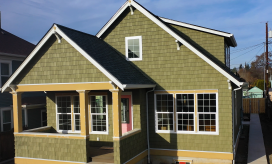
Low Carbon Construction
Sustainability starts long before construction begins, and our solutions will help make the world a better home for all.
Less Is More
A Key Distinction
Emitted carbon. Embodied carbon. What’s the difference? Embodied carbon refers to what is released when a product is manufactured; carbon emissions are what that manufactured product releases upon being used.
Why lower carbon?
Construction is responsible for 37% of global carbon. Low-carbon building helps reduce greenhouse gases. Choosing sustainable materials helps reduce embodied carbon in a structure before it’s even completed.
Recycled Materials
CertainTeed drywall plants recycle gypsum waste, allowing us to use less raw material. We also partner with suppliers to minimize construction site waste.
Durability
Products designed to last longer require less maintenance and replacement. That translates to energy and construction cost savings. Materials that last mean less production in the long run.
The Future
Thoughtful production helps lower carbon emissions during construction, but also sets up a carbon reduction future for the completed building.
Our Goals
By 2030, CertainTeed and Saint-Gobain will reduce CO2 emissions by 33%. By 2050, we’ll be carbon neutral.
Reducing Environmental Impact
Our system for low slope roof restoration keeps materials from going into landfills by eliminating the need to tear off and replace factory-made membranes.
Zero-Carbon Manufacturing
Upgrades at our Montreal wallboard manufacturing facility will reduce carbon emissions by up to 44,000 metric tons each year. When completed, it will be North America’s first zero-carbon manufacturing site.
Circularity In Action
Asphaltica technology enables us to pelletize post-industrial and post-consumer shingle scrap, diverting it from landfills. The pellets are an ideal component of asphalt paving mix for variable climate conditions.
Embracing Low Carbon Construction for a Greener World
From sustainable materials to energy-efficient designs, join us on the journey towards a sustainable tomorrow, where every structure tells a story of environmental stewardship.
Study Confirms Vinyl Siding the Sustainable Choice
Blog Post - Study Confirms Vinyl Siding the Sustainable Choice
.jpg?crop=yes&k=c&w=426&h=318&itok=fu8KdUwx)
Performance Benefits of Sustainable Insulation
New Year, New Roof? Let’s Find Out!


.jpg?crop=yes&k=c&w=272&h=164&itok=asXYC8cc)
